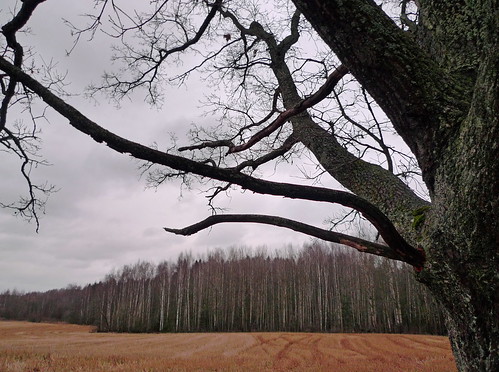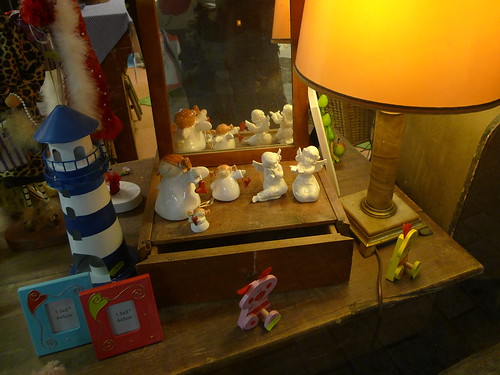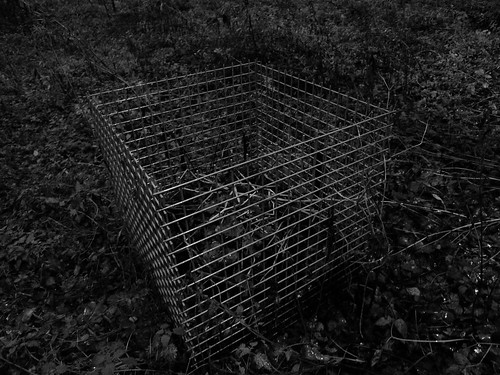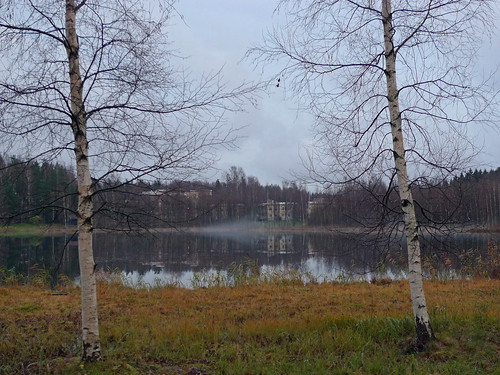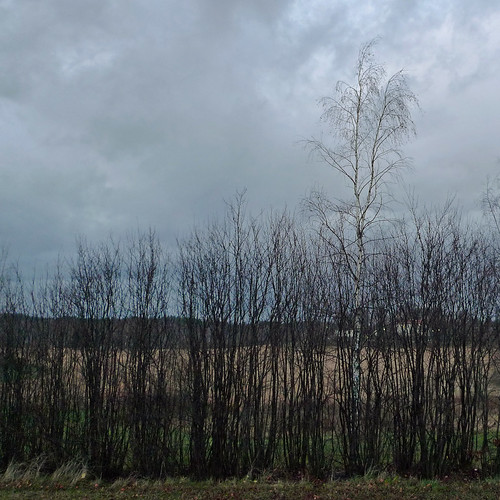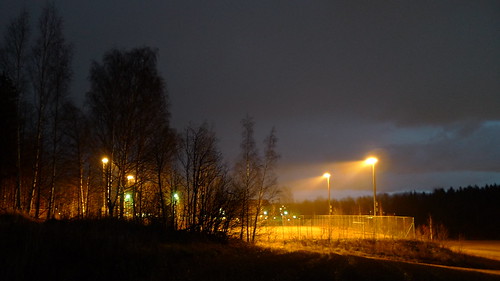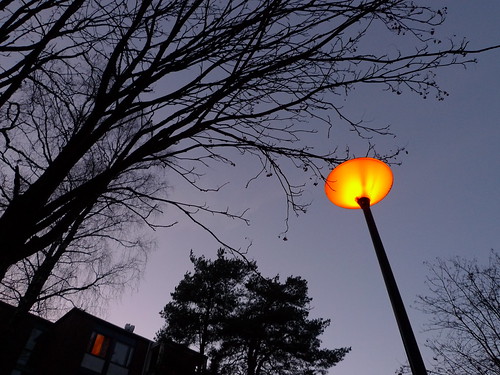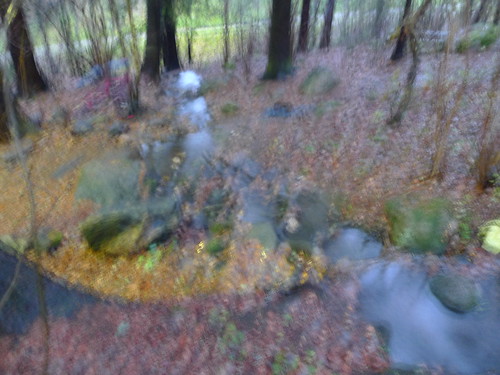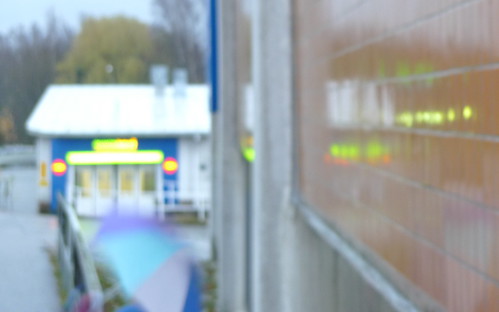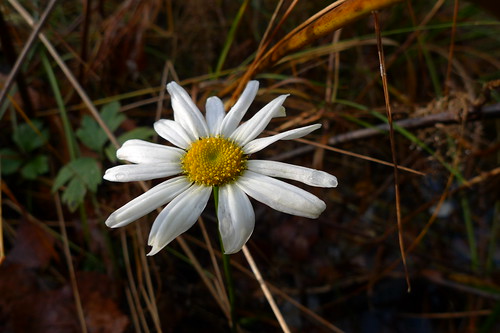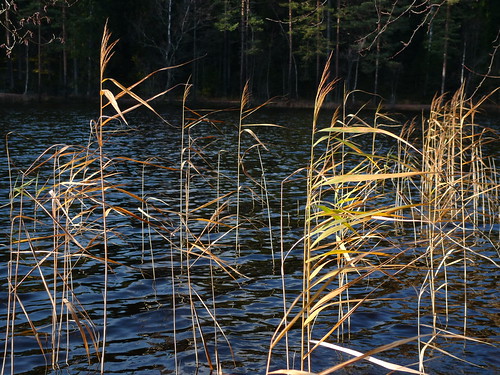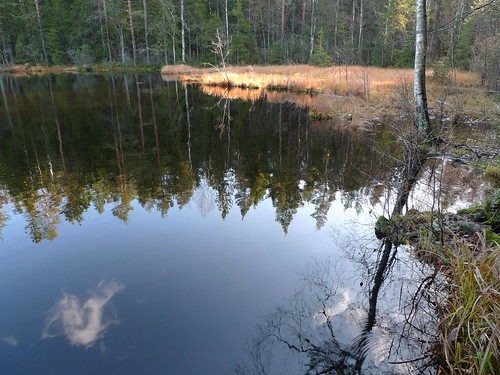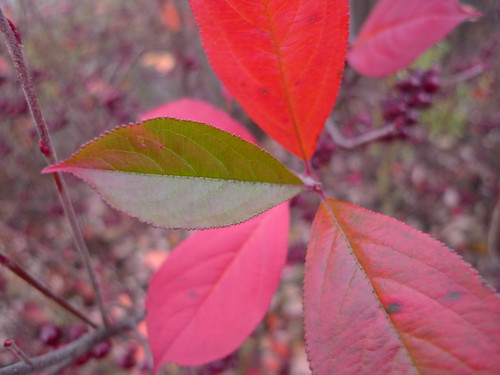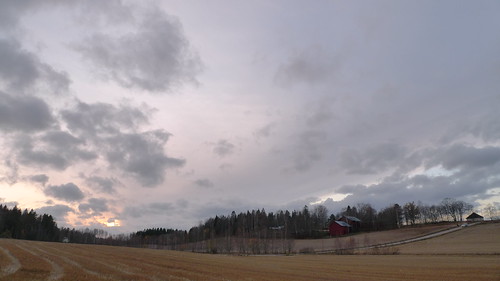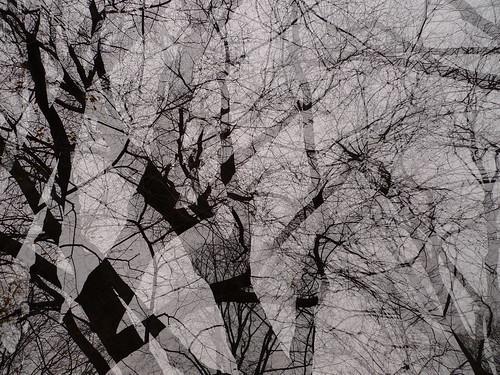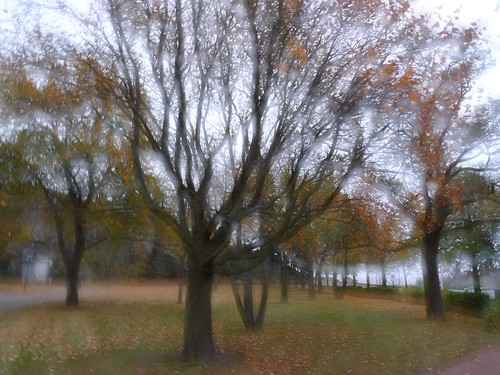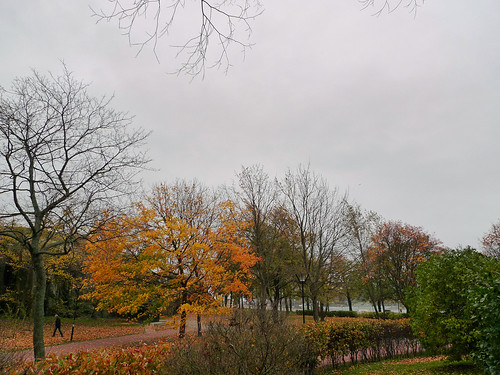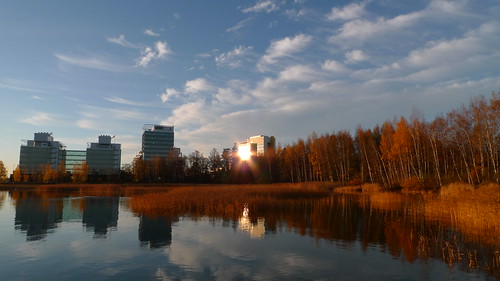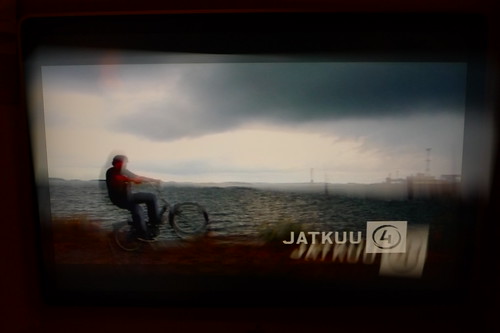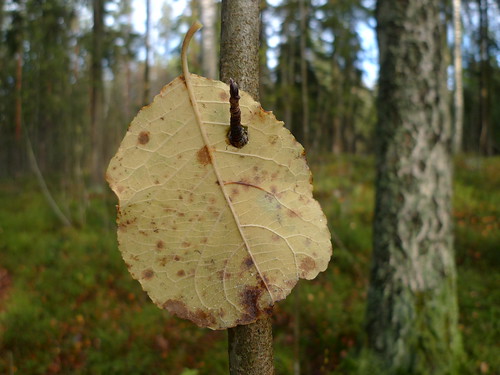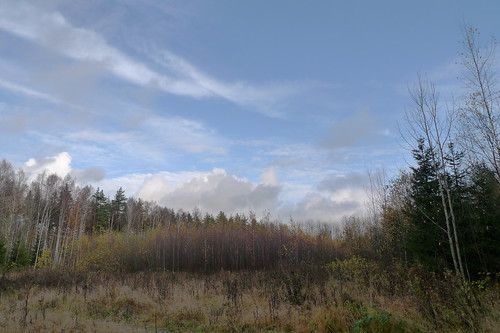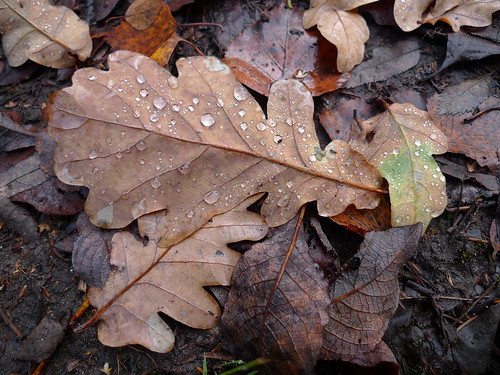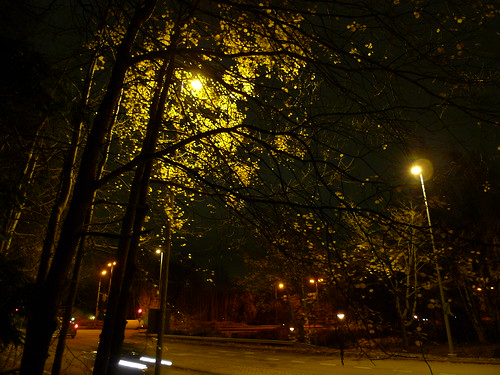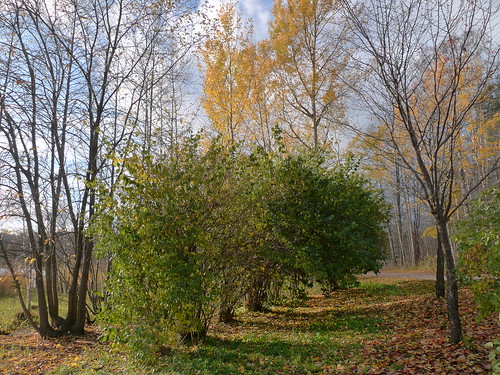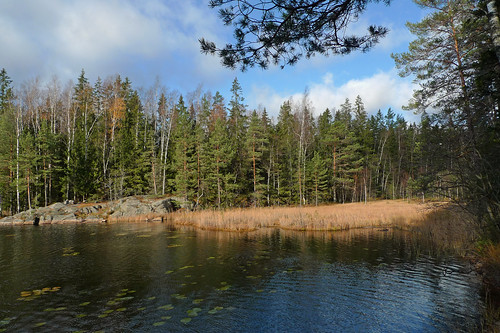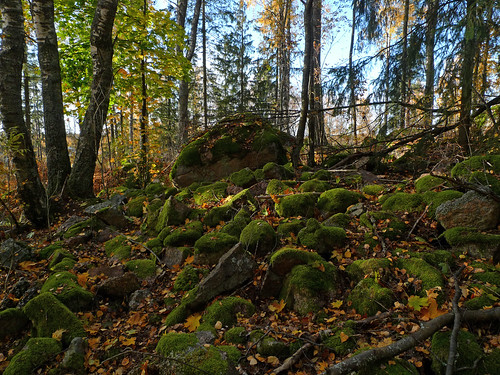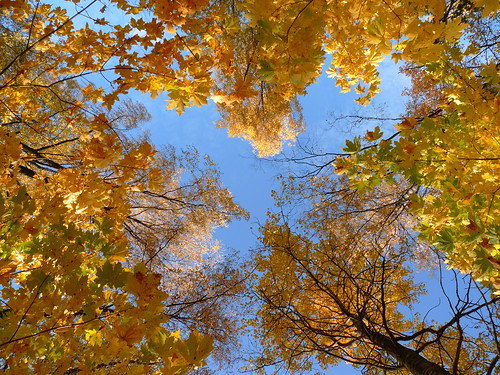We have got more than enough water during the last few days. Sometimes the rain has been pouring down, sometimes trickling. But it seems that the rain is never going to cease completely. For photography this is not so nice. It get dark early, and rain spoils much of the daylight hours. I really hope we get some nice weather during the weekend, but it seems that the weather forecasts change rapidly, so you never know.
Friday, October 31, 2008
Thursday, October 30, 2008
Noticing things
Some people seem to notice all kinds of small things - such as coins or interesting objects dropped on the street. I'm usually blind to such things, although every once in a while I'm aware of the environment.
I feel that photography is a way of opening up to the visual riches of the world, a means of removing the blinds so to speak. Since starting to take more photos this spring I have been a bit more observant, especially about nature, things like leaf color and patterns, cloud formations, colors of cars or buildings or sunsets, and so on. You could say that a photographer is a one-eyed person in the world of the blind.
The darkest time of the year
It is definitely starting to be a hard time for photography here in Finland, at least when using available light. Today it started to darken already at 4 pm, thanks to the heavy cloud cover and rain. I went for a walk outside, but photography was next to impossible in the rain and darkness. I tried a bit of b&w photography, but when there is little light, even that was hard to do. Perhaps it will be better tomorrow.
Wednesday, October 29, 2008
A camera for children
Some time ago I speculated whether I should offer my old Canon Digital Ixus 400 to the children for doing photography. Today they tried it out in the evening, shooting 180 photos in an hour. And then they selected the 60 best and edited some of them in iPhoto.
Some of the photos were quite creative, perhaps better than I have been able to do. I didn't need to help much, everything worked as it is supposed to. Perhaps the children have watched me so much that they already know what to do. Or the Ixus and iPhoto just are easy to use.
About the two photos shown here... This morning reminded me of something which I had forgotten: the beauty of ice and show. Even though the autumn is getting darker all the time, there is the promise of light when snow and ice appear. But until then, it is gray, dark and wet.
Which is the best - Canon G10, Nikon P6000 or Panasonic LX3?
Luminous Landscape made a comparison between the Canon G10 and Nikon P6000, also referring to an earlier review of the Panasonic LX3.
All cameras got quite good marks, and in the end it is the personal preferences and sensitivity to price which decides. The LX3 is smallest and cheapest, whereas the G10 is biggest. It seems that the P6000 is sort of loser in the competition, it is not a match to the G10 in capability and the LX3 in price and size.
The Luminus Landscape review was certainly interesting, but I feel the reviewer had a kind of landscape-photographer's bias. How the camera performs at low ISO is certainly important when you are shooting with a tripod, and size of the camera doesn't matter so much.
Which camera to select - that is not so easy, but it is good to have choices. You need to know your needs. Also, the camera you select also influences your shooting habits.
I'm happy with my LX3, but if buying a camera right now I would surely try out the G10 and P6000 as well. But as it is so dark here in Finland most of the year, the f/2.0 lens and good high-ISO properties plus smaller size would probably put the LX3 on top.
Update: The recent PhotographyBLOG review of the P6000 has this to say of the competition: "The Nikon Coolpix P6000 is a good camera in its own right, but doesn't quite cut the mustard when compared to its main rivals, the Canon PowerShot G10 and Panasonic Lumix DMC-LX3." Indeed, it is apparent that high-megapixel compact cameras have trouble with noise at higher sensitivities, as is to be expected.
From autumn storm to freezing in hours
Yesterday evening we had a strom with wind, rain and thunder, but at night the clouds went away and it got freezing. While waiting for the car to warm up I took a few photos of frost on plants. Nice ice formations were everywhere. Some autumn leaves were still remaining, and they had got nice frost borders.
A neighbour came and wondered what I was doing. After explaining he noted that it is good to have a camera with you always. But colors often turn out different in the photos. Well, that is true - but with the settings I'm using on the LX3 the colors are usually reasonably close to the original. Such was the case here. And with digital photos you can fix them afterwards. (Although I don't have patience for such editing except in very rare cases.)
Tuesday, October 28, 2008
Photographing the world
This evening I read a photography book by Freeman Patterson, "Photographing the World Around You". It is a good, short book, containing a lot of hints and exercises to free the reader from fixed conventions about what makes a photograph. Patterson is good in explaining complicated things simply (perhaps they are not so complicated after all), such as the basic abstract shapes which form a photo. There were a lot of ideas in the book to explore at some point.
This photograph was taken today evening just as a storm front was approaching. I was not really paying attention to the subject, but there was something interesting in a tree fence which had become semi-transparent when the leaves had fallen. There is also a kind of order in the complexity which I like. I tried different aspect ratios with the image, and finally used a square. This seems to fit quite nicely. I'm quite happy with the result, although the subject is perhaps not so happy.
It was a dark and stormy night
Weather turned bad this evening. We had thick clouds, strong wind, cold rain - and also thunder and lightning. However, after being inside for most of the day it was good to go for a walk outside regardless of the weather. And as they say, it is only a question of having the right clothes.
I took some photos in the scant available light. Here the exposure was 0.769 seconds, handheld. I must say the result is really impressive, almost no camera shake blur is visible. The image stabilization of the LX3 proved once again itself. You can see the rain in the light from the lamps, blurred due to the long exposure.
Different kinds of fuzziness
How to make fuzzy photos which do have impact? I have been experimenting with different kinds of unpreciseness, but it is difficult to progress. In this photo there are several different kinds of blurriness - motion blur (moving car and leaves in the wind), out-of-focus blur, and unpreciseness of colors due to heavy cloud cover in the evening.
The image has some good qualities, but could be much better if the elements would come better together. But taking this photo was good practise in any case.
Monday, October 27, 2008
Mystery object
I'm not quite sure what this thing is, but someone had put it on top of a playground fence. Shiny it is at least. Once again, an opporturnity to test the limited depth-of-field behaviour of the LX3. I like this kind of finds, there are all kinds of things laying around in surprising places. Usually you just don't notice them.
I'm thinking whether I'm taking too many photos. When I was shooting film, I took 200-300 photos per year (except some years when I got really interested and burned a dozen rolls of film in a month). Now I'm taking the same number of photos in a day.
Is that excessive? Think more, shoot less?
On the other hand, I'm learning from looking at the failed photos. Each failure teaches a lesson, at least I hope so.
Secret
There is a saying attributed to photographer Diane Arbus: "A photograph is a secret about a secret. The more it tells you the less you know." I don't think too much of my own photographs, but I do like the mystery some photos pose for the viewer.
Here I tried to crop the photo in such a way as to cause some problem-solving thinking. --- I'm not sure if I really succeeded. And in any case, Arbus was referring to the secrets of human beings - and of life - when I'm usually not capable of such deep thoughts.
Today my column on the Panasonic LX3 appeared in MikroPC.net (in Finnish). I'm thankful for all the advice I have got on the net from other users of the camera, it has been really great six weeks of learning. And I'm sure I'll keep on doing photography with the LX3.
There was another interesting posting about the LX3 by Laurence Kim, comparing the camera performance at high ISO. This made me think to try out ISO 800 photography using the "dynamic b&w" film mode. I'm really impressed how nice images the LX3 produces in black and white.
Here is once again an updated list of Panasonic LX3 reviews:
- Laurence Kim
- Imaging Resource
- Luminous Landscape
- Digital Camera Resource
- Nargalzius
- Camera Labs
- Digital Camera Review
- DKamera review translated into English
- Let's Go Digital
- Digital Camera Info (DCI)
- LX3 ISO photos --- Imaging Resource "Comparometer"
- Burnblue
- Plemix
- Photoreview
- Pocket Lint
- DIWA labs (measurements)
- Cnet (Asia)
- ePhotozine
- Lawrence Ripsher
- Photography Blog
Wintertime
Last weekend Finland shifted from summertime to wintertime. We get one extra hour of sleep, brighter mornings - but darker evenings. It is getting dark already at six, so there is little time for photography, even when the day is not clouded.
I took quite many shots of the children at play, but due to the scant light I had to use a long exposure, and motion blur was excessive. But a few of those photos succeeded. I also took some landscape photos, but didn't really have a lot of interest for it. I feel that this photo of a lamp post was best of the photos. The lamp had just been switched on and thus was very yellow.
Imperfect
On Sunday I mainly produced imperfect photos, such as this one with motion blur. But on the other hand, this photo shows well the wet autumn weather, where you need some protection from the elements. And it was indeed wet, water was flowing downhill in streams and the wet leaves were collected in piles by the walkway.
I like this kind of imperfect photography, this is what I would like to develop further, not the still landscapes where nothing much happens.
Or perhaps I want to do both kinds of photography. Sunday was just a day when I needed some imperfection.
Sunday, October 26, 2008
Unprecise photos
Sometimes it is the "failed" photos which turn out interesting. Here I took a photo of a quite dark forest, and only after pressing the trigger realized that the exposure was five seconds. (So it goes when the image stabilization make you forget about camera shake.)
Well, I tried to hold the camera steady, not expecting anything worth saving. But in the end the result was suprising - perhaps the photo is not so good, but it does show some qualities of an interesting image regardless. An unexpected capture of a wet autumn forest.
Photography in stormy weather
Today we had rain and wind here in Finland, and there was little light for photography. We went for a short walk, but there was hardly any inspiration for photography. Perhaps it was the weather, perhaps I was still tired from the previous week. I did some experiments with focusing and longer exposure - different kinds of blurriness - but few of the photos were any good. In the photo shown here I got a somewhat lighter feeling, thus I feel it is not so bad.
What to do with an old camera?
I have several old cameras around, and every once in a while I think what to do with them. The Minolta XG-1 is one camera which I will not get rid of, it was my first own camera, and I have a big attachement to it although I no longer use it.
Today I picked up the Canon Digital Ixus 400 and took a few test shots with it. It was suprisingly heavy, about the same as the LX3, and the trigger button needed a quite heavy press, compared to the LX3. I hadn't realized this difference between them. Otherwise using the Ixus was really easy, hard to forget, as it is a simple camera. But I'm no longer interested in using it - I immediately felt a loss of control compared to the LX3.
I'm thinking that perhaps the children could use the Ixus. At least it would give them something to practise photography on, at least it is durable and easy to use. Perhaps they will get interested (but I'm not so sure about that, they have so many other interests already).
The photo here was taken with the LX3 today, a nice flower reminding of the summer.
Saturday, October 25, 2008
Photography to see the world - or to create one
While taking photos today and later looking at them it was interesting to ponder how photography is at the same time similar to the ordinary way of looking at the world, and different from it.
It is not only that we have two eyes and stereo vision, or that the brain actually "makes up" a view of the world from glipses put together from partial views between rapid eye movements. It is also that each type a camera (and the lens in use) have their own characteristics, generating a quite special type of world view.
In fact, some are even of the opinion that film cameras and digital cameras perform differently, digital being precise and bright but also flat, without a three dimensional impact.
I'm slowly learning to know the kind of view the Panasonic LX3 generates, but still occasionally there are surprises. I do like the f/2.0 lens, which makes it possible to do background blurriness in macro shots, even though in a limited fashion.
I can definetely understand that kind of photography where the blurriness is maxed with full-frame or bigger sensors and long tele objectives. It is a way of removing complexity from the photos, painting with light. However, it is different from the way we are usually looking at the world with our eyes.
Another similar thing is motion blur. The eye does have a similar capacity, as shown by the way we fool ourselves in the movies, thinking that a rapidly changing series of images is "live". But the camera is a controlled way of making use of the blur. Motion blur is often used as a way of removing unneeded complexity from photos - though sometimes also in the opposite way.
What I have been looking at with interest recently is photographs where these kinds of effects have been used for a great artistic effects - out-of-focus blurriness, motion blur, multiplex exposure, and so on.
I'm interested to experiment with these techniques, but so far I haven't managed to produce anything worthwhile. Just ordinary photos serving mainly a documentary function.
The difficulty of capturing beauty
The reeds growing in the lake Halkolampi were an exciting photography subject for me, but unfortunately I didn't manage to capture the beauty in a photo. I took several dozen photos, but all had something wrong with them.
Many photos had extra stuff such as tree branches sticking in from the sides. In others the position of the reeds didn't please the eye, or the symmetry was somehow not pleasing.
In the end none of the photos was really what I was aiming at. Perhaps the reason was the wide lens - using a tele might have compressed the reeds into a tighter formation, allowing to get the same feeling like it was there by the lake.
Mysteries don't make great photos
It is often difficult for me to know whether a certain photo has any interest or meaning for others. For example this photo is for me an interesting one, but at the same time I think it won't have much interest for others.
There is a sort of puzzle in the shadow and light of the trees, but that does not necessarily mean that a photo containing such things is a good one. But perhaps someone may wonder why one tree is black and the other is light.
Walking in the nature
Today was a nice weather, and so we went for a long walk with the family, over two hours in all. I managed to do a nice amount of photography, some of the photos succeeded rather well. Unfortunately, some of those I was hoping would be great were not so good after all. But so it goes - you try and fail, time and time again.
There are several lakes near each other in the Luukki forests in Espoo. We walked by two of them, first passing Kaitalampi and then walking around Halkolampi. Weather was nice, not too cold, and sun was shining brightly. The photo here shows the south end of Halkolampi, where the wind did not reach.
Autumn leaf colors have almost passed, so it is not so colorful anymore, but there are nice views nevertheless. A nice relaxing day. It was good to be outside and enjoy the lake, forest, and sunshine.
Friday, October 24, 2008
What it is about flower shops?
Today I once again went by a flower shop window and took a photo. This view seems to lighten up the gray Finnish autumn which is getting darker each day. Even though I didn't do anything to make this photo - just pressed a button - it makes me happy to have it. A feeling of noticing something nice, and not having just passed by.
Autumn photography
Today was a gray, gray day. I took a lot of photos, but few had any idea, and even fewer showed even a bit of a promise.
I'm not sure whether the bad weather and weak light was really the reason for the bad photos. Perhaps it was just being tired, being worn out with excessive thinking at work, and being busy with all kinds of things all the time.
I'm every so often wishing to have a bit longer tele in my camera. The 60 mm has been usually enough, but not always. Every so often I would like to reach a bit farther, for example into tall trees. But in most other cases I can just move closer and then take a photo.
What I'm not willing to compromise on is the small size of a camera. The LX3 is just the right size, bigger would be inconvenient. Perhaps in time there will be interchangeable lens cameras - or at least compacts with bigger sensors - in the same size category. Then I would be willing to switch. The Panasonic G1 is not yet what I would like to have, but getting close to that.
Watch Big Brother Finland - or take photographs?
There was today a news item here in Finland that Big Brother and Idols get more viewers than tv news, which have been the most popular thing earlier. I'm not contributing to the statistics, as I hardly ever have time to watch news, and certainly not Big Brother or Idols. What I'm sometimes watching is House (recorded, usually several days later than transmitted) and movies.
Then I also started to think how much time I'm investing in photography. Quite a lot - taking photos, processing them (deleting 90-95%), and organizing them. And discussing photography-related topics on the net.
If I would need to choose whether to watch Big Brother or shoot photos - there would be no contest.
Thursday, October 23, 2008
Three photography sessions today
I spend quite a lot of time with photography today. First I took (hastily, but still) a few photos of the Laajalahti bay at noon or so. Then, before sunset I went for a walk with the children, and took quite a few photos of the park area. And at night I went for a walk with my wife, and took a few night photos.
I was a bit surprised at the quality of the LX3 night photos when short at ISO 80 on a tripod. Colors are better than they eye could see, but also the details are there. If I would have known this I would have tried to frame the photos a bit better, but it was difficult in the dark. Next time I'll try to do better.
How long will the Panasonic LX3 last - less than one year?
Today I did some photography at the Laajalahti bay while going to make a speech. It was beautiful, but few people seemed to notice anything. Many of the photos succeeded at least technically, and it was difficult to select a favorite. But here is one of the photos.
Today I'm at 8,200 photos taken with the LX3. At this rate, I will take 78,763 photos in a year with the camera. But will it last that long? Entry-level DSLRs are rated at 50,000 shutter cycles, how much is the LX3 worth?
Update: Blogger was under maintainance for some time this night (Finnish time), so I didn't manage to do much blogging. Perhaps tomorrow I have more time to discuss photography.
Wednesday, October 22, 2008
Being present (and being playful)
I titled this photo "Teeth" for obvious reasons. But that was not why I took this photo. Instead I noticed an abandoned bicycle in the forest and wanted to do something different, feeling a bit playful. And although the photo may not be perfect, it was fun to take it.
Later I was pointed towards a nice posting about photography, titled How to disappear: "Photography is only a little bit about cameras and lenses and technique. [...] That's maybe 20% of the job. The rest is presence. [...] I'm engaged in what is happening around me in the moment. And I'm engaged, as a witness, to what is happening inside me as I hang with the scene I'm in. It's from that dual attention that I work the photographs."
The requirement of being present may explain why it seems that I have to shoot 100 photos before getting one reasonable good one, and then I may get several in succession. It takes time to get rid of all of the other stuff requiring attention and just be in the moment, flow with it, play with it.
What I have found out is that the best moments in doing photography are the playful ones - doing something just for the fun of it, not expecting anything great, just trying what will happen. In those moments there is something similar than when children play - they are totally focused, but not forced to focus, they just are there in the moment and go with it, not having other voices in the head demanding attention.
That is for me the real secret of photography - it allows me to play, and makes me to be present.
Update: "Being present" seems as a concept similar to "the flow", as described in Wikipedia: "Flow is the mental state of operation in which the person is fully immersed in what he or she is doing by a feeling of energized focus, full involvement, and success in the process of the activity."
Last bright autumn leaves
This photo here was a bit of a surprise when viewed on the screen, but I should have anticipated the strong contrast between red and green. There is still a liitle bit of autumn colors left outside, although most leaves have fallen and are turning brown.
One of the LX3 mysteries which I have been pondering was revealed to me today - the way how sometimes the color balance seems to flip, and the photos will have a "flat" or "washed" look instead of strong colors.
Today I understood that this was due to using i.exposure which tries to compensate when the image has extremely large contrast. Sometimes you get two completely different-looking photos within seconds, due to small changes in brightness which triggers the i.exposure mode on. (It is not always on but only when needed.) So, the solution is either to live with it or turn it off. I'm not sure which way I'll go.
Photography exercise
I made today a mistake of reading Panasonic LX3 discussions at the Dpreview forums - the home of the pixel-peeping elite. There was quite a lot of pointed commentary about "small sensor" lack of depth and real dynamic range. Well, it may be so, but I'm still enjoying the LX3 very much, and I feel it produces much better photos than my Minolta XG-1 ever did. So, I'm not nostalgic about the past. Instead, I embrace our digital camera future.
Today took quite a lot of photos when going out for a walk. I didn't shoot many subjects but instead took tens of photos of a single subject, trying different effects.
Tuesday, October 21, 2008
Sea at storm
I was browsing through the photos from today - out of 339 photos taken, only 20 were somewhat worth preserving. I'm not sure if I like this sea view either, but at least it is among the better ones from today.
With the thick cloud cover, it was difficult to get a good contrast in the photos. Also, the wind was so strong that 2/3 of the photos had blur due to camera shake, despite the optical image stabilization. (Shutter speeds were between 1/30 and 1/100 second.)
Multiple exposures with the LX3
While practising protography in the center of Helsinki, I did some experiments with multiple exposures on the LX3. Not exactly great art, but interesting results nevertheless.
First I tried tree silhouettes in different positions. Next, I tried a view of the Kaivopuisto park, with precise focusing and with an out-of-focus image superimposed. For this to really work you would need a tripod, I think.
Photographing the city landscape
I haven't done much photography in a city, by which I mean the tightly built and densely populated areas of a city. Today afternoon and evening I was in Helsinki, and had some time between meetings to do some photography. It was stormy weather, so few people were walking outside. Also, thick clouds removed much of the color from the landscape.
As the city landscape is unknown subject matter to me, I didn't get many halfway decent photos, but this was good practice nevertheless. Later it got really dark, and there was little light, but I tried to do some b&w photography nevertheless. The results were not so great, but at least I tried.
Update: I noticed only later that I didn't save any of the "street view" photos of Helsinki, although I took quite a lot of them. Either I didn't like them, or they were technically bad (camera shake, too dark etc.). Apparently I'm a natural landscape photographer.
Yet another review of the LX3
Imaging Resource posted a detailed review of the LX3, here is a quote: "I found the 24mm wide lens a lot of fun, giving the Panasonic LX3 a slightly different personality from its closest competitors. And the quality of the images was an unqualified joy to behold." There were some negatives, as there naturally is in such a specialized camera, but all in all this was perhaps the most positive review of the LX3 so far.
Here is once again an updated list of Panasonic LX3 reviews:
- Imaging Resource
- Luminous Landscape
- Digital Camera Resource
- Nargalzius
- Camera Labs
- Digital Camera Review
- DKamera review translated into English
- Let's Go Digital
- Digital Camera Info (DCI)
- LX3 ISO photos --- Imaging Resource "Comparometer"
- Burnblue
- Plemix
- Photoreview
- Pocket Lint
- DIWA labs (measurements)
- Cnet (Asia)
- ePhotozine
- Lawrence Ripsher
- Photography Blog
Monday, October 20, 2008
What focal length are you using with the LX3?
I thought that I have been taking most of my LX3 photos using 24 mm, but I was not sure of what is the exact percentage. So, I did some Google searches, and found a tool to get the EXIF information from jpeg files on Mac OS X. Here is the result:
1 images / Focal Length: 5.8 mm (35 mm equivalent: 35.1 mm) 1 images / Focal Length: 8.8 mm (35 mm equivalent: 53.0 mm) 1 images / Focal Length: 9.4 mm (35 mm equivalent: 56.6 mm) 2 images / Focal Length: 7.7 mm (35 mm equivalent: 46.8 mm) 5 images / Focal Length: 12.1 mm (35 mm equivalent: 57.0 mm) 8 images / Focal Length: 11.1 mm (35 mm equivalent: 52.0 mm) 8 images / Focal Length: 5.4 mm (35 mm equivalent: 26.0 mm) 9 images / Focal Length: 6.3 mm (35 mm equivalent: 30.0 mm) 10 images / Focal Length: 6.8 mm (35 mm equivalent: 32.0 mm) 11 images / Focal Length: 5.9 mm (35 mm equivalent: 28.0 mm) 16 images / Focal Length: 8.8 mm (35 mm equivalent: 41.0 mm) 17 images / Focal Length: 9.3 mm (35 mm equivalent: 44.0 mm) 19 images / Focal Length: 10.2 mm (35 mm equivalent: 48.0 mm) 23 images / Focal Length: 7.9 mm (35 mm equivalent: 37.0 mm) 31 images / Focal Length: 7.4 mm (35 mm equivalent: 35.0 mm) 121 images / Focal Length: 12.8 mm (35 mm equivalent: 60.0 mm) 1266 images / Focal Length: 5.1 mm (35 mm equivalent: 24.0 mm)So, over 80% were taken at 24 mm, and less that 10% at 60 mm. (I have taken over 7300 photos, but kept only a fraction of them.)
For those who have a Mac and know unix, here are a few hints how to get this statistics.
I installed the exiftool program, which works on the command line, and did some command line work in the iPhoto folder library. Files with names of the form P10*.JPG were taken with the LX3. (Fortunately Canon has a different naming scheme.)
Here is a one-line command to gather the statistics on Mac OS X:
exiftool P10*.JPG | grep Focal | grep equivalent | sort | uniq -c | sortThis did the trick although it is not pretty. (Actually, I used a bit more involved version of the command using "find", but if the files are in one directory, there is no need for it.)
Addendum: It may be better to use a command line of the form
exiftool P???????.JPG | grep "Focal Length In 35mm Format" > DATAAfter this, proceed as above.
On the LX3 - lens vs. software
Today I had little time for photography, except in the morning while riding a bike to work, when I took a few hasty shots of the Laajalahti bay. A bit boring photos, but some practise nevertheless.
There has been a series of interesting discussions going on the Dpreview.com forums on the "Leica" lens of the LX3 with and without the software corrections which the Venus IV engine does in-camera to the jpeg files.
It seems that the lens of the LX3 provides quite a good resolution (in RAW), but has a lot of chromatic aberrations and distortion at the wide end. The software corrects the problems automatically in the jpeg files, but if you want to use the RAW files, there is currently only the Silkypix software which can handle them, and it doesn't do as nice a job of "fixing the flaws".
So, the LX3 is a system with a lens and software which go together, and trying to use the RAW files is quite challenging. Some don't think this is acceptable. For me it is, as the jpeg files are excellent in quality, provided that you set the exposure correctly.
Having a lens which goes to 24 mm, can do macro shots in 1 cm distance, and is attached to a camera with excellent handling - what more can you hope for?
Multiple exposures
I was going to test today what can be done with the LX3 using the multiple exposure feature, but didn't have time for photography in the afternoon. All kinds of possibilities are worth investigating - shooting the same landscape/macro subject first in focus and then in an out-of-focus version. Of shooting a silhouette of a tree multiple times with different placements, generating an abstract rendering of tree shapes.
Or you can try shooting the same subject first with a fast shutter speed, and then with a slow one, using a panning motion. This is what I tried yesterday evening in this photo (two exposures superimposed). First I took a normal still photo of the iMac screen (showing a tv program), which I then combined in-camera with a circular panning version of the view using a longer exposure (and a smaller aperture). Although the subject is not great, this photo shows one version of the possible effects. And this is easy to do, as the LX3 screen shows the a preview of how the multiple exposures are going to look like superimposed. But I really would like to try this out in more detail with a real subject.
Random occurrences
While walking out in the nature you see all kinds of surprises, some of which seem to be impossible. Like finding autumn leaves stuck in interesting places. For example, in this photo, was there a hole in the leaf already before or was it generated when impaling on the tree? Man-made or nature-made?
Moving from holes to external viewfinders. I have checked out the Ikodot, which is a simple external viewfinder for LX3-style cameras. It is so simple that you could build one yourself - but you are paying for the idea. It is USD 99 with standard shipping. A bit high, but perhaps it would be worth trying out anyway. I'm still hesitating - with about 50 dollars more you can get an optical Voigtlander viewfinder.
Sunday, October 19, 2008
A new week ahead
Today was a mostly clouded day, although there were occasional glimpses of the blue sky. Most of the autumn colors have fallen to the ground, but some are still remaining, as shown in this photo.
This evening I read Freeman Patterson's book "Photography for the Joy of It". It contains many deep thoughs about photography, especially the discussion on how a photograph reveals both the subject and the photographer, however abstract the subject. The book also includes all manner of interesting hints, such as photographing snow (I hope we will have some this winter), use of multiple exposures, deliberate use of out-of-focus, breathing to the lens to get "smooth" halos around bright lights etc.
I did some experiments with multiple exposures with the LX3, and even though they weren't great as photos, they showed that it is quite easy with the LX3. You can shoot the same scene with different settings, exposure and focusing, or you can combine difference scenes in one photo, or you can do both a still and panning version of the same subject in one photo.
Lots of possibilities there, and with the LX3 it is quite easy, as the camera shows a preview of the multiple exposure while you are shooting. This is certainly something worth exploring futher. Also, night photography (long exposures) need to be tried out a bit more that I have done. So much to learn...
Late autumn
It is getting late in the year, and the fallen leaves are turning brown. Today was a clouded day, but not raining all the time, so it was possible to go for a walk with the family.
I noticed a detailed posting about the LX3 by Nargalzius, actually more like a mini-review that a blog posting. Here is a quote with a quote: 'As for me, I’m just happy that I’ve finally got a practical camera, which can perform well enough for me to do everyday shooting without thinking “How I wish I had my DSLR right now.”'
I'm now thinking about getting an external viewfinder to use with the LX3 - for landscape photography and low-light photography. And also for trying out something new, a new style of photography. But the Panasonic version is too expensive, so I'm thinking about a 25 mm Voigtlander, or some cheaper one. There should be a lot of offerings but somehow there seems to no retailer that is shipping them to Finland.
Goodbye to street photography?
(The photo here is not street photography but a photo of a street. I hope you don't mind. I was trying out what can be done handheld with the Panasonic LX3.)
There is an interesting discussion at Photo.net, the original posting was titled Is street photography fast becoming a thing of the past?: "Digital has indeed nothing to do with it. It only means that more people are taking photo's not that there are more photographers. Mediocrity rules, as you can clearly see on this site and all other photography related ones. Fastfood instead of quality food. [...] I think street photography has its place in the history of photography. However, most people I know pretty much think that photographing strangers on the street is a kind of stalking and think that its practitioners are weird and doing something unethical. "
I haven't really done street photography, although a few of my photos do show a street and people there. Partly I'm very much in favor of privacy, and don't want to disturb it, and partly I feel that I don't have an interest to walk the streets - I want to be off the streets if at all possible, out there in the nature.
However, I'm interested in this photography genre - it provides inspiration for taking photos of the family, especially the children. But I'm not showing those photos publicly.
Saturday, October 18, 2008
Lighting up the images
Now that autumn is upon us here in Finland, I feel that I'm going to try to get the best of the light when it is available. Also, I'm intentionally aiming for as light-toned photos as possible, not avoiding overexposure the way I have been doing previously.
Today I took almost 400 photos in all, first at the Lake Myllyjärvi and then later at the Lake Lammaslampi. It is surprising how much there is to be found (in terms of new photos) even in familiar settings. As I wrote here earlier, perhaps the perfect photo is one meter away from you.
Update: I was thinking about my current way of using the LX3 - aperture priority, manual focusing - compared to the way I started to use it, first the fully automatic iA mode and then the P mode with automatic focusing. The biggest hurdle in learning to use the LX3 was that the iA mode was confusing for me - I tried to control it and the idea of the mode is that the camera is in total control. Also, I was used to the Canon Ixus 400, and the LX3 is very different in terms of menus and setup. And there are so many settings that it is confusing if you try to learn everything at once.
With manual focusing I can use the automatic focus when I want (by pressing the focus button). And with aperture priority I can control the depth of field - necessary as I'm taking a lot of landscape and macro photos. Also, even though the focus lag is usually small, it can be sometimes 1/2 - 1 second, and I want instant response which I get with the manual focusing mode.
And most of all - I want to learn photography, not to be on the mercy of automatics (however clever).
Blurry landscape
I haven't done much unsharp photography, but here I tried to use the f/2.0 lens of the LX3 to limit the depth of field. I'm not very good at this kind of composing, and it seems that you have to have a tripod to really frame the subject in the best possible way.
The wind was also complicating the photography, it was like a dance, trying to keep the focus right and the background elements in reasonable order. No a big success, but good practise nevertheless.
A walk by a lake
We visited today the Myllyjärvi lake in Espoo, where we went also a couple of weeks ago. Then the autumn colors were in full bloom, now they have almost passed. The fir and pine are much in force this time of the year.
I took a couple of hundred photos at the lake, but it wasn't quite as nice as the last time. There were more clouds, a lot of wind, and less color.
At one point I slipped on the rocks and almost hit the LX3 agaist stone. I'm not sure what would have happened then. On the other hand, the LX3 is strong in construction, but on the other hand, optics are fragile. Luckily this time I didn't test the durability although it was close. Have to be more careful in the future.
Friday, October 17, 2008
Out for a night walk
I tried to take a few photos outside today when it was already dark. Even a handheld one second exposure of a dark sparsely lighted lake view, which didn't turn out too bad. The image stabilization of the LX3 functions well (although this is pressing the point a bit too far). But I didn't include that photo here, but instead one with more light.
I'm not sure what to think of photographs like this shop window - the flower shop staff have decorated the window in a nice way, so what is the photographer's contribution? Standing in front of the window and pressing a button?
But whatever you think of the photographer's role, I do think that this is a nice display. And the LX3 did an excellent job here, reproducing the colors as they were in despite the complex artificial lighting.
Photography while commuting
Today while riding a bike on the way home I took a few photos of the Laajalahti/Otaniemi area in Espoo. One subject was this chair by the reeds of Laajalahti, seemingly abandoned.
One challenge in photography is the control of depth of field. I have been practising a bit, but still it doesn't come naturally any more. And what I remember from my 35 mm SLR does not apply to the 1/1.6 inch sensor of the LX3. In any case, usually there is no problem in having enough depth of field, but the reverse is sometimes a problem. But occasionally when taking closeups there is need to go to f/4 or even f/8 to get the subject wholly sharp.
Walks in the nature are good for children
This is only slightly related to photography, but here goes. A new study shows that a walk in the park improves attention in children with ADHD: 'For children with Attention Deficit Hyperactivity Disorder (ADHD) tasks that require concentration such as doing homework or taking a test can be very difficult. A simple, inexpensive remedy may be a "dose of nature." [...] after the walk in the park children generally concentrated better than they did after a walk in the downtown area or the neighborhood area. The greenest space was best at improving attention after exposure.'
During the last summer we went with the children to the nearby nature parks and wilderness areas several times each week, and it was good for everyone. (Not only me and my photography.) I have always felt that out there in the nature (and after been there) it is easier to think, but now for the first time we have a controlled comparison where there seems to be proof about this claim.
The photo here was taken on Wednesday on a nature walk just before sunset.
Thursday, October 16, 2008
Yet another LX3 review - Luminous Landscape
Luminous Landscape published a review of Panasonic LX3 titled Very Wide – Very Fast – Very Nice, which was so nice that I can't help putting two quotes here:
"But full manual control of exposure as well as focusing is available, and like just about everything else on this Panasonic it's well conceived and presented. Unlike with some cameras, one gets the sense that real photographers had input into the camera's design, rather than a committee of engineers and marketing people. [...]
"This camera's combination of high build quality, a terrific lens, wide angle coverage, a wide aperture second to none, and extensive and easy to use manual controls, makes it quite appealing to the serious photographer looking for a pocket camera."
The reviewer was using the LX3 in the same way as I - aperture priority and manual focusing using the focus button when needed. However, he was shooting in RAW whereas I have been happy to work with jpeg. Perhaps I should try Silkypix once again, if only to check out the exposure control in RAW and perhaps HDR type shooting with the LX3.
The photo here was taken a week ago when there were more autumn colors on trees and less on the ground.
Here is once again an updated list of Panasonic LX3 reviews:
- Luminous Landscape
- Digital Camera Resource
- Camera Labs
- Digital Camera Review
- DKamera review translated into English
- Let's Go Digital
- Digital Camera Info (DCI)
- LX3 ISO photos --- Imaging Resource "Comparometer"
- Burnblue
- Plemix
- Photoreview
- Pocket Lint
- DIWA labs (measurements)
- Cnet (Asia)
- ePhotozine
- Lawrence Ripsher
- Photography Blog
No new photos today (almost)
It was raining today, quite heavily, and I was busy at work (discussing strategy) and at home (helping children to draw). I took no new photos today. Well, actually I took a couple of photos of plans written on a whiteboard, but that is not really photography.
So, this was for a long time a day without photography. Luckily I have quite a lot of photos in store, such as this one taken a week ago. The weather was fine then, as were the autumn colors.
